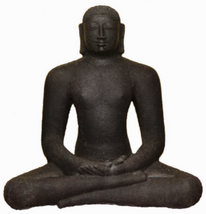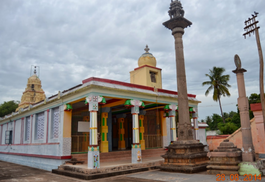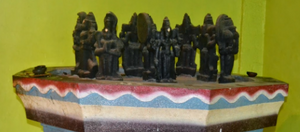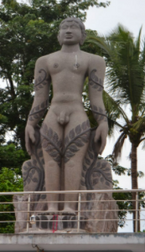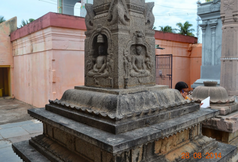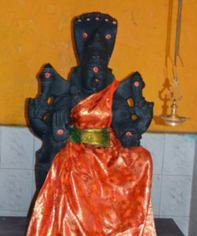Uppuvelur Aadhinathar Temple
இந்தப் பக்கத்தை தமிழில் வாசிக்க: உப்புவேலூர் ஆதிநாதர்கோயில்
Uppuvelur Aadhinathar Temple (15th century C.E) is a Jain temple located at Uppuvelur in Villupuram district, Northern Tamil Nadu (Tondaimandalam).
Location
Aadhinathar Temple is located at Uppuvelur, also known as Velur, which is twenty-three kilometers southeast of Tindivanam.
History
Uppuvelur has been a place of Jain religious importance since the 15th century C.E. Uppuvelur is one of the villages with a large number of Jains in Tamil Nadu.
Structure
Aadhinathar Temple had Karuvarai (Sanctum sanctorum) Arthamandabam and Mugamandabam earlier. It lost its antique artistic features due to frequent renovation. At present, this temple structurally looks like a long hall, with Karuvarai(Sanctum sanctorum) at the back, Arthamandabam at the center, Mahamandabam beside it and Mugamandabam at the front. Like the temple, the compound wall, gopuram and a hall right next to the north side of it were renovated many times. The final reconstruction of the temple was twenty years ago.
Through the artistry of some of the sculptures of this temple and via Mackenzie's manuscripts, we can determine that Uppuvelur Aadhinathar Temple belongs to 15th century C.E.
Sculptures
In the Sanctum sanctorum of the temple there is a four feet high sculpture of Aadinathar in meditation posture. At the bottom of the plinth is a small bull, his symbol. This sculpture does not have decorations or Mukkudai (Triple Umbrella) like other idols. This statue has 15th-century C.E's artistic style. Along the north wall of the hall next to the Sanctum sanctorum is a beautiful sculpture of Darumadevi Yakshi. At Darumadevi's right feet are two children and parallel to it sculptures of two chowry bearers. Instead of Prabhai behind the head of the goddess, there is a shape of Kamuga tree with lobes at the top of the crown. They belong to 15th century C.E. Kshetrapala, Jwalamalini and Rishabhanatha installed in a separate pedestal and other sculptures found in this temple are all created in the twentieth century.
An 18 feet high stone statue of Bahubali standing on a 18 feet high platform like the one in Shravanabelagola has recently been erected in the south-east side of the temple.
Cheppu Thirumeni (A Sacred Copper body)
There are so many Cheppu Thirumeni in Aadhinathar Temple. Among these are the images of Aadhinathar, Mahavira Parshvanatha, Bahubali, Ganadharar, Chaturvimsati Tirthankaras, Daruma Devi, Sarvaana Yakshan, Poorana Putkalai, Dharanendra, Jinvani, Padmavati and Jwalamalini are notable. All these were cast within one hundred and fifty years.
Inscriptions
Uppuvelur Aadhinathar Temple should have many inscriptions earlier. Charters could have lost due to frequent renovations. In 1919, the epigraphers copied an inscription from the northern wall of the temple. This inscription states that Jayasenar (18th or 19th century) renovated the temple.
An inscription is also found at the base of a pillar in the hall to the north of the tower. The complete message of this charter mixed with Grantha and Tamil could not be known. The 'Salivagana' year mentioned in this is corresponding to the year 1909 C.E. From this it can be seen that Samuthravijaya Nainar from Uppuvelur and Ayyanna Nainar must have built or renovated this mandapam in 1909.
Some of the pedestals of the metal 'Thirumeni' inside the temple hall bear the names of their donors. Among these, there is a message created in 1932 on the pedestal of Lord Parshvanatha, which is considered to be ancient.
Veerasenachariyar
The credit for establishing the first shrine in Sithamoor belongs to a monk from Uppuvelur. Veerasenachariyar was the foremost Jain monk from Uppuvelur. He established the Chittamur Mutt in the 16th century C.E. Venkatapati, the Nayakka king who ruled the Gingee, caused hardships to the Jain people, so the Jain people went to other places in large numbers. Veerasenachariyar went to Shravanabelagola in Karnataka alone and learned Jain Shastra. Mackenzie's manuscripts says Veerasenachariyar returned to Gingee and established a mutt in Chittamur.
Worship
Daily poojas, Nandheeswara deepa pooja, special poojas are also held in the temple. On Akshaya Tritiya, the statue of Aadinathar is anointed by the Panduka statue placed on the wall at the north-east corner of the temple and taken on Thiruveethiula (a street procession). Amman Thiruveethiula (a street procession) is also held on days like Kaanum Pongal and Aadi Velli.
References
- Tondai Nadu Jain Temples(Dr. A. Ekambaranathan); 1991
- AHIMSAI YATRAI: UPPUVELUR
✅Finalised Page
